 |
| Happy Campers director Amy Nicholson with Anne-Katrin Titze: “There are times when you get lucky and you get magic.” |
I first met Amy Nicholson in 2013 when I was on the jury of the inaugural First Time Fest with Gay Talese, the B-52’s Fred Schneider, and Killer Films’ Christine Vachon. Amy’s documentary, Zipper: Coney Island's Last Wild Ride, won our Outstanding Achievement in Editing Award (by John Young and Jonah Moran): “Fast-paced editing that captures, in a balanced way, a story about humanity in an age of greed. The editing works like the Zipper itself, connecting the ride with the story of Coney Island.”
 |
| Amy Nicholson often places the people side-by-side, Wes Anderson style. |
In Happy Campers, a highlight of the 14th edition of DOC NYC (edited by John Young and Laura Israel, director of Don’t Blink - Robert Frank), we are taken to the Inlet View RV Park campground on Chincoteague Island in Virginia. Nicholson often places the people side-by-side, Wes Anderson style, facing the camera straight on, when they show off something interesting - for instance, two kids holding up freshly-caught crabs or a group of rambunctious men with their latest home-improvement tinkering inventions. The houses look partially homemade, the campers decorated with personal memorabilia, though not pink and a bit more dishevelled, they share the barrier-free feel of Barbie houses. This seaside community, so much is clear from the start, has been a summer escape for generations.
Everybody seems to know everybody, and if they don’t, they surely would like to get to know whoever is drawn to their idiosyncratic haven. “They think of us as little people” a woman says, when it becomes clear that this will be the last summer before the place as is will be erased from the map for redevelopment. “Amy, did you eat?” we hear a concerned voice shout out to the unseen filmmaker. For a celebration there are homemade American flag cupcakes and impressive fireworks, the men throw horseshoes, kids and dogs and cats roam freely, and a group of slightly tipsy mermaids perform a makeshift water ballet for Amy that amuses them just as much as it does us.
Images initially may easily trigger viewers to think they know who these people are and to put them in a clearly defined political box. Once you suspend preconceived notions, a much fuller picture unfolds. It is one of community, one that America and the world is in dire need of.
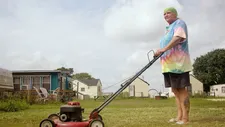 |
| Amy Nicholson: “I went to film my friend Tammy while she was mowing the lawn and she was mowing the lawns of people who had already left.” Photo: Amy Nicholson, courtesy of Myrtle & Olive |
From New York City, Amy Nicholson joined me on Zoom for an in-depth conversation on Happy Campers.
Anne-Katrin Titze: Hi, Amy, good to see you!
Amy Nicholson: Hi, Anne-Katrin, how are you? It’s been a long time!
AKT: Yes, but I do think about you quite often when I use this [I show Amy the tote bag from her previous film, Zipper] for market shopping!
AN: Beautiful! Oh, when it gets old I can get you a new one! You look exactly the same!
AKT: You, too! Lovely to reconnect. Everything, including the pandemic, has happened in the world since.
AN: I mean, the world has really gone off its axis! I’m a little delirious today because we stayed up really late last night.
AKT: It was your première!
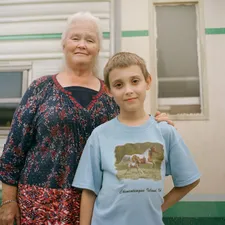 |
| Amy Nicholson on Marsha with her grandson Ethan in Happy Campers Photo: Amy Nicholson |
AN: Yes, it was great. It went really really well. I had Jaie Laplante to introduce the film. He took the film for the festival back in the summer, before we had finished it and he had never seen it with final sound or music; I’m not even sure he saw the final cut. He walked up afterwards and said, oh, it’s really good! I was like, well you did program it! Some of the people who are in it came.
AKT: Did you first encounter the campground or did you first have an idea that you wanted to make a film about a campground?
AN: I first encountered the campground! Because I grew up going to Chincoteague [Virginia]. That’s what you do when you live in Baltimore, around Maryland, around Delaware. The people who came last night were actually from Jersey, so they were the people that travelled the furthest to go there and I don’t even know how they found it. It’s a very specific place. It’s based on Marguerite Henry’s book Misty of Chincoteague. I went in there one winter, taking pictures and I just fell in love with the houses and was chuckling to myself. This was like 15 years ago.
These are are tiny houses, but Dwell magazine would have a heart attack. It was the middle of the winter, so they were all closed and I could walk around and take pictures, but years and years later, my husband and I were looking for property because my dad lives down around Chesapeake. We were driving around and I said, go into that campground! It was summer, and I thought, wow, what a great community! So we rented a place for the last part of the summer.
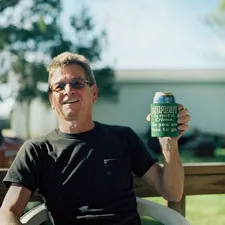 |
| Scotty in Happy Campers Photo: Amy Nicholson |
By fall I was in love with it. I found a camper, I bought it and I moved in. I think I always knew in the back of my mind that I would do something. Everybody has their name on their house and the places are ten feet apart. The first summer I was invited to a potluck, to which the whole campground came. I didn’t really start filming until year three.
AKT: It’s obvious how much they love you. One of the best questions, I don’t think any filmmaker has captured on film before, is one of your subjects saying to the camera “Amy, do you have any garbage?”
AN: I know! Because there was a big dumpster. That’s the place, if you go to a grocery store, you ask somebody if they need anything. People help each other. As a matter of fact, if you weren’t friendly you wouldn’t fit in very well.
AKT: The closeness and openness of the houses actually reminded me of Barbie and the Barbie houses. When you play with your toys you have this openness, the friendliness, the playfulness.
AN: That’s a great analogy! It’s really true. There were different parts of the campground - the whole thing was basically a horseshoe and most of the places were around the waterfront. There were no fences or anything. Most people walked, not on the roads, but across people’s yards. You would wave and stop and talk.
AKT: Some of your shots are just so funny and lovely. The one with the two kids holding the crabs facing the camera felt very Wes Anderson. Very amusing placements!
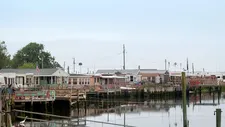 |
| Waterfront homes in Happy Campers Photo: Amy Nicholson, courtesy of Myrtle & Olive |
AN: Oh thank you.
AKT: The details are pretty fantastic - a kite on a fishing rod!
AN: That’s Carl. He made the kite and also the trashcan weathervane. He was the man who did the fireworks. He had this amazing dock and put the fireworks on the dock. If you look in the fireworks scene closely, there’s one really big wide shot, one of my favourite shots in the film, and there’s Carl, this big [she shows someone very small with her fingers] walking back amongst all the sparklers. I miss him, I miss all the people.
AKT: When the film begins we don’t yet know that this will be the last summer.
AN: We cut it that way. We had a cut, oh, Anne-Katrin, we had a cut for so long … but you had to kind of live the story to get the story. We had a cut early on where about eight minutes into the film, the woman is on the phone saying it’s going to close down. There was a letter sent to all of us and we had people talk about the letter they got, saying all had to be out by October 1. Then we did a rough-cut screening with fellow filmmakers and because we made such a big deal about it, they were searching for, well then this is the issue, and they’re going to fight it. Because that’s the way so many documentaries are done. And it just didn’t work.
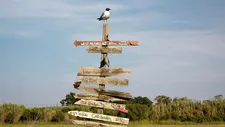 |
| Inlet View mileage signs Photo: Amy Nicholson, courtesy of Myrtle & Olive |
So we took the whole thing apart, and trust me, we thought we were done editing. We were like, no, this is not the way it happened. We knew, everyone was in denial, including me. And as the summer wore on, people would be much more passionate. I went to film my friend Tammy while she was mowing the lawn and she was mowing the lawns of people who had already left. She was like, I have to mow the lawn because it’s just making me feel better. Then she stopped the mower and just started talking to me. The emotion that comes out toward the back half of the film is truer to how the story should unfold.
AKT: Which summer was that?
AN: 2019, so right before Covid. Covid hit the next year and everybody, including me, was like, wow, it would be great if we had that place to go to. It’s been redeveloped now but it sat empty for about three or four years.
AKT: I liked the shop you show there - with the sunglasses and pots and little toy horses. Anybody who remembers stumbling upon places like that can almost smell it.
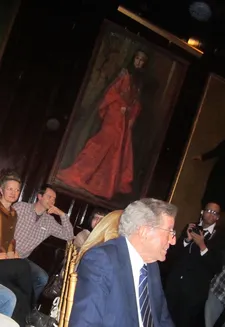 |
| Tony Bennett with Amy Nicholson and John Young at Players Club during the First Time Fest Awards Photo: Anne-Katrin Titze |
AN: I’m so glad you said that because I have been joking that if I could have, you know, John Waters’s Smell-orama card [Odorama: scratch-and-sniff cards]? It would be so great, because it would smell like open fire, like bug spray, suntan lotion, and that plastic smell of beachballs, you know?
AKT: That beachball plastic smell, I love!
AN: And salty air! It’s very marshy there, it’s tidal water. The campground was right at the end of the island, so it was surrounded by water and everything rusted there.
AKT: Has John Waters seen the film?
AN: I wish! I don’t think so. I wish I could send it to him, getting his opinion on it. Fingers crossed, I’ve entered Provincetown Film Festival, which I’d love to do and I know he’s very involved in that. I’d like to do more festivals along the coastline, now that we’ve premiered. It’s a very specific thing, these places where people gather and there’s a lot of them. But they’re slowly disappearing.
AKT: I could ask John Waters.
AN: I would be happy! Please do! I think he would really like it, because when you’re from Baltimore, you know about all these places.
AKT: You mentioned the shot with the little man which makes me think of another shot where we see a tiny green light at the other end of the bay in the distance. It was very F Scott Fitzgerald, that green light.
AN: There was no placement by me. That probably just exists there.
AKT: The moment when the sign comes down which shows where everybody lives, is very touching.
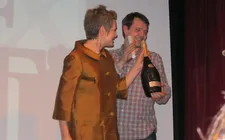 |
| Amy Nicholson with co-editor John Young accepting First Time Fest Outstanding Achievement in Editing Award Photo: Anne-Katrin Titze |
AN: I know, it’s sad. They kept it, the couple that is the first couple to speak. They came last night. I had a screening for all the people who lived there, including those who had lived there in the past. We had a big screening in Chincoteague. It was a rough-cut screening back in the summer. They really appreciated it; it was almost like a reunion. I just did it selfishly as a filmmaker to make sure everyone was okay with everything I show. But I also wanted to see everyone again; it was really fun.
AKT: Were there people who said, no, no, don’t show me that way?
AN: There was one woman whose story is still in there, it’s part of the party. But she just didn’t want to show her face for some reason. I’m very respectful. There were some people who, as I was filming, said, hey, don’t show me drinking and partying. I said, okay, no problem. So everyone who was like drinking and smoking, especially Scotty, who is the one who moons the camera - anything like that, I would call people and say, I’m just telling you, you’re at a party in a bathing suit, is that okay? And I would send them screenshots or little clips - so I did all that homework.
AKT: They do have gigantic beverage cups!
AN: I did, too! In my little cart I had this big, what I call, adult sippy cup and it was usually filled half with wine, half with seltzer.
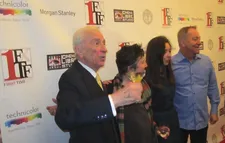 |
| 2013 First Time Fest jury Gay Talese, Christine Vachon, Anne-Katrin Titze and Fred Schneider Photo: Ed Bahlman |
AKT: I see!
AN: I would usually film and then would join in. They were my friends!
AKT: A wonderful scene is when the little boy gives a tour of his grandmother’s camper!
AN: He just did that! There are times when you get lucky and you get magic. I had just met them. It was his grandma’s place and she had gotten him for the summer. One day I went by and we started talking and then I said, do you want to give me a tour? And he was like, oh yeah! You can hear grandma in the background but he wanted to give the tour. That kid is a teenager now. The dog is still alive, still going strong.
AKT: Is he the same one who introduces his dog?
AN: Same kid.
AKT: Who made the same birthday for the dog! It’s so lovely.
AN: It’s so sweet.
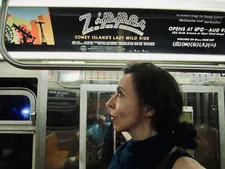 |
| Zipper: Coney Island's Last Wild Ride on the NYC subway Photo: Anne-Katrin Titze |
AKT: All of it - you show a community and people just being nice to each other, which we see far too rarely. It’s a big deal.
AN: Somebody last night, Anne-Katrin, they said in one of the questions from the Q&A - a man said, what didn’t you show? Were there fights? Was there some discord in the community that you didn’t show? What did you leave out? And I said “Nothing!” First of all, I didn’t shoot enough material because I was so busy having fun. I said, the only thing I left out was when people requested not to be shown drinking. There were no big fights and I think it’s really hard for people to believe.
AKT: Early on someone says this is “the armpit of America.”
AN: That was my neighbours, Mary and Chris.
AKT: At first we may think, aha, okay, hm. Then this description is repeated later on in the film and it has a totally different meaning. Armpit, really? It may be closer to the heart!
AN: Right, that’s exactly the point of it. That’s why we put it right after the poem. Everyone I talked to was so far from being bitter or angry. Yeah, we did get mad at the end; it did kind of sink in. But almost everyone would say to me, I’m so grateful for the time we had. Weren’t we lucky to have it as long as we did?
AKT: It ties it in with Zipper, which was also about memory and fun. Do you have a new project?
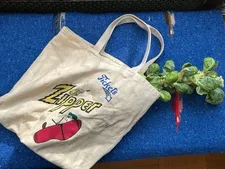 |
| Zipper tote bag Photo: Anne-Katrin Titze |
AN: No, I don’t have it yet. This was really difficult to get any kind of funding, I think for multiple reasons. Because I filmed it right before Covid and then during Covid everybody did what I did and had all the time in the world to work on their films. A lot of films were in that pipeline and I think the poor funders were inundated. And there’s a push for more traditional impact films with funding and it was hard to explain what the importance of this was.
And I try, as you say, as with Zipper, the thing I struggle with the most in life is that I don’t like the monetisation and the corporatisation of everything. I just hate it. And I hate how homogenised the world becomes when that happens. You know, like if you go on a roadtrip and you pass an exit and it’s the same seven restaurants and the same five stores. And people say, oh isn’t it great, there’s a Starbucks, I’ll know exactly what I’m getting in my coffee! And I’m like, not really. That’s my personal beef with society. I think that’s why I’m drawn to things that are organic and a lot more touchy-feely, and a little more analogue.
And the third thing - these are working-class people and they get amalgamated with Trumpers. Which is really a humongous mistake for anyone who watches the film. You cannot believe the things people said to me! People would say, oh yeah, and the Trump flags. There are no Trump flags in the film! There are American flags but there are no Trump flags. Or people would see things that weren’t there. I think it’s a shame that that’s where we’ve gotten, we’re so divided and the irony for me is that the film really shows that when you drop all of that, you really can sit - I have no idea what the politics of my neighbours were - I know of a few of them but it didn’t matter even.
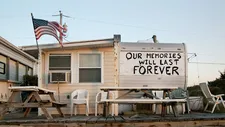 |
| Our memories will last forever in Happy Campers Photo: Amy Nicholson, courtesy of Myrtle & Olive |
AKT: I think you make your viewers forget about politics, too.
AN: I actually wrote that in one of my proposals. I started to get a little hint of maybe who those people are is a problem for some people. Because you’re dealing with a very liberal, very left-leaning, as I am, that’s who you’re dealing with when applying for funding. So I started writing this paragraph - yes, I understand on the surface this is what this seems like, but I’m hopeful that not only will people forget about that, but that this might bridge the divide. That the next time you see someone portrayed in the media, who is predominantly white, let’s face it, working-class, you will not assume who they are. I hope that’s kind of a side benefit of the film.
AKT: The individuality that doesn’t fit the divided moulds is so important to recognise and preserve. The non-corporate store in your film, the one I mentioned earlier, made me think of a trip many years ago to Bodega Bay, of all places, where in a small mom-and-pop store, I bought a T-shirt that says Bodega Bay with a seagull on it, which is still one of my most prized possessions.
AN: Ha! My prized possession is from the store [in the film] and it is for when you have a picnic and it’s a miniature wooden picnic table and there are two holes in the middle and it’s a server for your mustard and ketchup. It comes with a little yellow squeeze bottle and a red squeeze bottle and then on the ends there are salt and pepper shakers, it’s so great. I’m just going to keep it in the box forever. I remember she was cleaning out the store in the end and I was like, don’t sell that one! I want that one!
AKT: Amy, it was so nice to reconnect!
AN: Oh thank you, Anne-Katrin, so much for doing this, I appreciate it!
Happy Campers will be available online through Sunday, November 26.





















